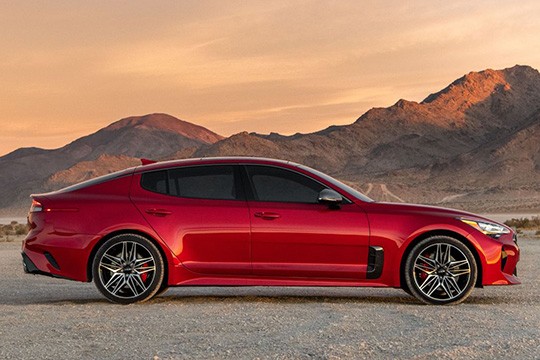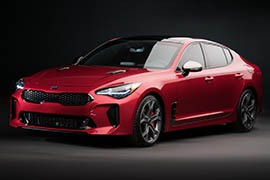KIA Stinger Models/Series Timeline, Specifications & Photos
First production year: 2017
Engines: Gasoline, Diesel
When Kia introduced the Stinger in 2017, it was like poking a wasp nest with a stick, and the automotive world was in shock: it aimed directly at the Audi A5/BMW 4 Series GT customers.
The Korean carmaker didn't want to make another right car for common people. It tried, and succeeded, to build a driver's car with four doors. When it was launched, everyone tried to find parts of the car that resembled other vehicles on the market, but Kia couldn't care more about that. It just charged forward with its turbocharged engines and rear- or all-wheel-drive systems. Then, in 2021, it charged even harder with the facelifted version.
Kia changed its logo at the beginning of 2021, and the Stinger came fitted with it. Overall, there were no significant changes in the car's look, and that was fine since it already looked great. The carmaker upgraded the headlights and taillights to an LED system, which provided more light and less energy consumption.
Inside, there was a new 10.3" touch-screen on top of the center stack. But the instrument cluster still kept the analog dials while the carmaker didn't consider that it was necessary to replace them with a TFT display.
The most significant change was under the hood. Kia dropped the turbocharged 2.0-liter unit and introduced the 2.5-liter version as the base model. The new four-pot unit provided 300 hp, 45 more than on its predecessors. The 3.3-liter V-6 remained the same.
Nobody expected Kia to produce a car that could compete against BMW's 4 Series Gran Coupe or Audi's A5 Sportback, and yet the Korean automaker did it with the Stinger.
The Stinger was a sporty-looking five-door hatchback that could keep up with the best in the premium compact segment, even though the Korean automaker was not invited to that table. Just to be sure that the car would perform according to its look, Kia tested it on the Nurburgring Nordschleife in Germany and built it on top of a shortened version of the Hyundai Genesis G70 platform.
The design team led by Peter Schreyer made the Stinger with the same "tiger nose" signature front fascia flanked by a pair of narrow headlights. In addition, the lower side of the bumper sported a broad grille in the air dam flanked on the sides by a pair of scoops that cooled the brakes. From its profile, the low greenhouse and the sloped back tailgate created an aerodynamic, sporty look for the vehicle.
Inside, the sporty feeling continued with the bolstered front seats separated by a tall center console that housed the gear stick (or gear selector, depending on the options) and the controls for the infotainment system. Kia installed a simple layout for the instrument panel with two large dials for the speedometer and tachometer and an LCD for the onboard computer. In the rear, the split-folding bench seat was mostly suitable for two passengers.
Kia offered the Stinger with a wide choice of engines, depending on the market. The base versions were powered by inline-four powerplants, while the top-of-the-range version sported a 3.3-liter biturbo V6 engine. Also, depending on the market and options, the car was available with either a rear or an all-wheel drive system.

